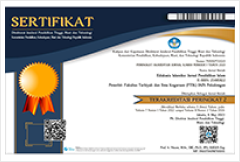The Response of the Participation Rate to Public Islamic Universities: Empirical Evidence from Central Java, Indonesia
DOI:
https://doi.org/10.28918/jei.v5i2.1080Keywords:
Participation Rate, Public Interests, Central Java, Public Islamic UniversitiesAbstract
The current study aims to investigate the participation rate of people in Central Java, Indonesia to public Islamic universities in the period of 2015-2017, i.e. perceptions, factor analysis, and public interest. Grounded in mixed methods, data were collected through questionnaires, interviews, and documentation. A total of 24,903 parents of prospective students situated in the areas of three public Islamic universities in Central Java became the research population. Proportionate random sampling was undertaken to yield 268 research participants. Study findings promote that firstly, the participation rate of people in Central Java to the government-funded Islamic universities reached 16.9 in 2016, 66.6 in 2017, and 67.3 in 2018 for percentages. Secondly, the average public perception rate to the public universities under the supervision of the Ministry of Religious Affairs was reported at the good criterion well with a score of 22.9. The majority of people demonstrated a positive view of the harmony of science and religious studies. Afterward, the average internal and external factors influence interest in the admission of the Islamic universities with an average score of 69.7 at the good enough level. Lastly, the public interest of Central Java in the universities achieved a score of 35.5 at the quite high criterion. This study also demonstrates that the public Islamic university’s services have provided excellent infrastructure, teaching staff, and student academic services. Nonetheless, various improvements are required, e.g. information technology and improvement of quality graduates to compete with other public universities.
References
Daulay, H. P. (2007). Sejarah Pertumbuhan dan Pembaharuan Pendidikan Islam di Indonesia. Jakarta: Kencana PrenadaMedia Group.
Djaali. (2011). Psikologi Pedidikan. Semarang: Bumi Aksara.
Fauzi, F. (2016). Membangun Strategi Perguruan Tinggi Keagamaan Islam Negeri (PTKIN) Menuju World Class University. Jurnal As-Salam, 1(1), 50–61. http://www.jurnal-assalam.org/index.php/JAS/article/view/44
Harun H., Wardhaningtyas, S., Khan, H. Z., An, Y., Masdar, R. (2019). Understanding the institutional challenges and impacts of higher education reforms in Indonesia. Public Money & Management, 1-9. DOI: 10.1080/09540962.2019.1627063
Hill, H., & Wie, T. K. (2012). Indonesian universities in transition: catching up and opening up. Bulletin of Indonesian Economic Studies, 48(2), 229-251. DOI: 10.1080/00074918.2012.694156
Jimenez, B. S. (2018). Assessing the efficacy of rational budgeting approaches: fiscal recovery planning and municipal budgetary solvency. Public Management Review, 1-23. DOI: 10.1080/14719037.2018.1497696
Johnes, G., & Tone, K. (2016). The efficiency of higher education institutions in England revisited: comparing alternative measures. Tertiary Education and Management, 1-15. DOI: 10.1080/13583883.2016.1203457
Kamila, F. (2018). Pengaruh Promosi, Motivasi, dan Harga Terhadap Minat Kuliah Program Pascasarjana Sekolah Tinggi Ilmu Ekonomi Indonesia (STEI). Jurnal Akuntansi dan Manajemen, 14(2), 1–12.
Kisbiyanto. (2016). Partisipasi Masyarakat Mengikuti Pendidikan di PTKIN. Edukasia: Jurnal Penelitian Pendidikan Islam, 11(2), 305–330.
Koesoema, D. (2015). Peta Jalan Pendidikan 12 tahun di Indonesia. Jakarta: Jaringan Pemantau Pendidikan Indonesia (JPPI).
Koeswara, E. (1991). Teori-teori Kepribadian. Bandung: Erecso.
Kusumastuti, D., & Idrus, N. (2017). Nurturing quality of higher education through national ranking: a potential empowerment model for developing countries, Quality in Higher Education, 1-19. DOI: 10.1080/13538322.2017.1407400
Makkulasse, R., & Sari, N. I. (2018). Implementasi Manajemen Sumber Daya Manusia (Msdm) Pada Perguruan Tinggi Keagamaan Islam Negeri (Ptkin). Dinamis: Journal of Islami, 1(1),10–17.
Mar’at. (1981). Sikap Manusia, Perubahan serta Pengukurannya. Yogyakarta: Ghalia Indonesia.
Marlius, D., & Ananda, F. (2020). Pengaruh Kualitas Pelayanan Website Akademik terhadap Minat Kuliah di AKBP Padang. Jurnal Pundi, 3(3), 191. https://doi.org/10.31575/jp.v3i3.190
Maslow, A. (1993). Motivation and Personality (Translated by Nurul Iman, Motivasi dan Kepribadian). Bandung: Remaja Rosda Karya.
Mudyahardjo, R. (2006). Pengantar Pendidikan, Sebuah Studi Awal tentang Dasar-dasar Pendidikan pada Umumnya dan Pendidikan di Indonesia. Depok: Raja Grafindo Persada.
Munoz, D. A. (2016). Assessing the research efficiency of higher education institutions in Chile: a data envelopment analysis approach. International Journal of Educational Management, 30(6), 1-29. http://dx.doi.org/10.1108/IJEM-03-2015-0022
Mustika, A., Desafitri R.B, L., & Irfal. (2019). Persepsi Siswa Terhadap Minat Kuliah Di Perguruan Tinggi Pariwisata. Jurnal Penelitian Manajemen, 1(April), 68–77.
Nugroho, N. E., & Cahyono, K. E. (2017). Pencitraan, Promosi, dan Kualitas Pelayanan Terhadap Minat Kuliah di Program Diploma III STIESIA Surabaya. Jurnal Mebis (Manajemen Dan Bisnis), 2(2), 42–48. https://doi.org/10.33005/mebis.v2i2.11
Rahman, A. (2016). Pengaruh Celebrity Endorser dan Public Relation terhadap Citra Perguruan Tinggi Swasta dan Minat Kuliah di Politeknik LP3I Jakarta. Jurnal Ilmiah Niagara, VIII(2).
Saifuddin, M., Niaga, P. A., & Surabaya, P. N. S. C. (2015). Pengaruh Kebutuhan, Tempat, Harga, dan Produk Terhadap Minat Kuliah Karyawan di Pakuwon Supermall. Jurnal Bisnis & Teknologi Politeknik NSC Surabaya, 2, 10–16.
Simanjuntak, P. (2000). Pengantar Ekonomi Sumber Daya Manusia. Jakarta: Fakultas Ekonomi Universitas Indonesia.
Slameto. (2003). Belajar dan Faktor-faktor yang Mempengaruhinya. Jakarta: Rineka Cipta.
Sofanudin, A. (2012). Model Peningkatan Minat Masyarakat terhadap Madrasah Ibtidiyah di Jawa Tengah. Jurnal Nadwa, 6(1), 91–113.
Sugiyono. (2008). Metode Penelitian Pendidikan: Pendekatan Kualitatif, Kuantitatif, dan R & D. Bandung: Alfabeta.
Suharman. (2005). Psikologi Kognitif. Bandung: Srikandi.
Suharti, T., & Nurhayati, I. (2017). Analisi Pengaruh Pencintraan,Promosi, dan Kualitas Pelayanan Terhadap Minat Kuliah di Universitas IBN Khaldun (UIKA) Bogor. Jurnal Ilmiah Inovator, 6(1), 59–88.
Susanti, A. (2017). Analisis Pengaruh Public Relations dan Pencitraan terhadap Minat Kuliah di Perguruan Tinggi Swasta. Jurnal Lentera Bisnis, 1(1), 1–18.
Uhbiyati, N. (1999). Ilmu Pendidikan Islam. Bandung: CV. Pustaka Setia.
Walgito, B. (2004). Pengantar Psikologi Umum. Yogyakarta: Penerbit Andi.
Winkel, W. S. (1991). Psikologi Pengajaran. Jakarta: Gramedia.
Zuhairini. (1983). Metodik Khusus Pendidikan Agama. Surabaya: Usaha Nasional.






















